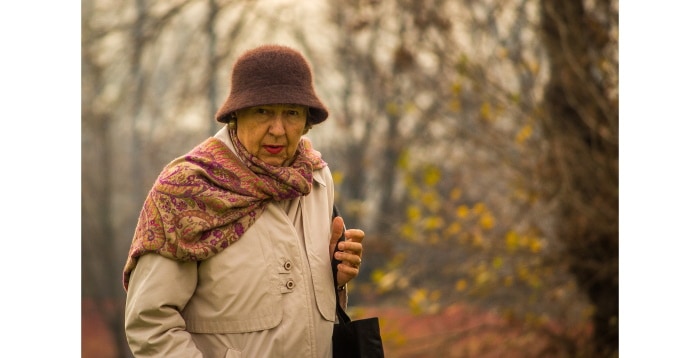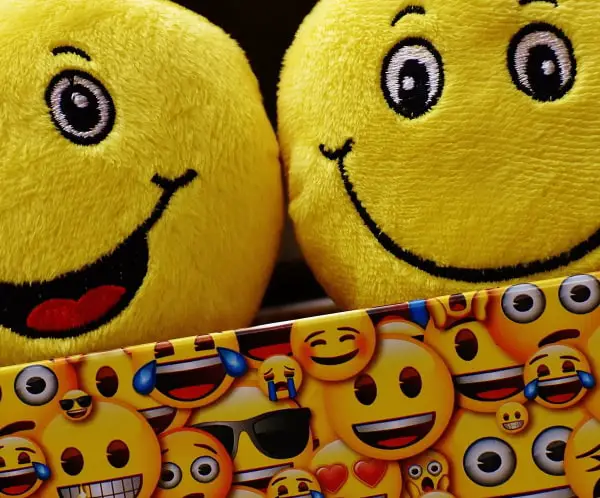Ever since I can remember I’ve been called ‘a smiley person’ but it’s always seemed like either a backhanded compliment or a compliment without true merit. So what does it actually mean to be a smiley person?
A smiley person is a person who smiles more than average for his or her community. Research also tells us that Americans in general are more smiley than people around the world, and that being a smiley person doesn’t exactly indicate happiness or friendliness either.

Being considered a smiley person in a land of smiley people, I’ve taken a personal approach to this topic. Below I’ve shared what I’ve learned about being smiley, and how I think this information can best inform teachers, parents, and grandparents of kids both smiley and not.
One way to build humor with your kids is to use it strategically through routines or regular activities. For instance, our Fun Jokes For Kids Coloring Book is a great tool for embedding humor through kid-friendly activity.
Contents
What does it mean to be a smiley person?
Before moving on, let’s consider what’s meant by being a smiley person.
Defining a smiley person is intricate. Research has identified external characteristics of being smiley with pulls at the mouth, eyes, or both and says that country, culture, and even sex are connected to smile frequency. Also, keep in mind the internal motivation for a smiley person varies greatly.
First, a smiley person is noticed by outward indicators. However, this depends upon the culture.
For example, in the US a smiley person is identified by the mouth, with corners pulling upward and teeth showing. In Japan, a smiley person is indicated more by the upper face, especially at the eyes with defined crow’s feet. Showing one’s teeth in a smile is considered rude.
Frequency of smiling is also culturally-connected according to research. For instance, it’s widely accepted that Americans smile more than any other country. In fact, in America big, toothy smiles are not only encouraged but expected.
In Russia and other Slavic cultures, however, people rarely smile in public or with strangers. It’s almost absurd to them, and certainly thought of as insincere.

For us Americans, though, smiling is so ingrained in our culture that even our cleaning products are shaped into smiles, like these Scrub Daddy sponges.
And to indoctrinate us early on just about all toys for kids have smiles carved into their plastic faces like these farm and safari animals from Fischer-Price Little People toys collection! (links to Amazon)
Is being smiley good?
Are smiling people happier? Is it good to be a smiley person? For Americans, overwhelmingly the answer is yes (but that doesn’t necessarily mean it’s true).
In American society, it is good to be smiley. A smiley person radiates positivity and happiness. From service workers to politicians, Americans think a person should smile upon greeting, during conversation, and as when saying goodbye, despite what one feels inwardly.
Americans smile for many reasons. For starters, it’s considered polite to smile at strangers. Some say it’s to show a sign of peace; others say it’s to overcome language barriers, since the US is a country full of immigrants.
No matter what the original intent, smiling has just become our norm.
If you walk into a store for shopping or to an office for an appointment, it is customary to expect the employee to greet you with a big smile. If not, Americans feel immediately rebuffed and on unwelcomed.
Well you say you got the blues,
Got holes in both of your shoes,
Feelin’ alone and confused,
You got to keep on smilin’, keep on smilin’
Wet Willie, 1974
Even our songs tell us to smile. From Louis Armstrong crooning ‘oh, when you’re smilin…’ in 1929 to Wet Willie telling us to ‘keep on smilin’ in 1974 to a more recent admonition by Justin Bieber that ‘when U smile, I smile’, Americans are told to smile.
Smile through the blues. Smile through the pain. Smile even when you’re world is upside down.
So is smiling good? Or maybe the better question is, ‘is smiling good for you?’
Most psychologists are in agreement that masking your true feelings is unhealthy. If smiling is a way to avoid confrontation, address problems in our lives, or deal with reality, then no, it’s not good, or good for us.
However, there’s a balance that experts suggest we strive for, because while it’s important to be honest with ourselves and those in our lives, there’s merit in thinking positively and having hope (Source: Mayo Clinic). And smiling can be a part of that experience.
As well, there’s nothing wrong per se with the American custom of smiling as a show of courtesy, or being rated the smiliest country in the world for that matter! As a person of the South (living in a southern state), my culture is considered particularly smiley for Americans, and this distinction is what sets us apart, along with our y’alls and comfort cuisine!
Smiley Americans (and smiley southern Americans) are known for hospitality demonstrated by our smiles. And it’s surely one of the reasons almost 80 million visitors come to the US each year!
Is being smiley a cover for something else?
Sometimes being especially smiley is a sign of something unhealthy or even disordered. Have you ever encountered someone who seems to always be smiling, regardless of the situation? I mean, it’s nice to smile (being American, and southern, I understand that), but smiling can be quite awkward when it makes no sense.
Being smiley can be a cover for something else. According to experts, someone who smiles a lot regardless of the situation may be covering for narcissism, psychopathy, or even severe depression. Getting to know a person closely or carefully monitoring for signs of masking can be helpful.
Because smiling is naturally aligned with good fortune or pleasure (Source: Psychological Science), it makes us uncomfortable when someone smiles at other times.
For instance, smiling when someone is hurt is disordered. Narcissists and psychopaths have a false smile, as they try to mimic social norms and expectations.
Some people who seem to smile all the time may actually suffer from something called ‘smiling depression.’ NAMI says that someone with smiling depression seems “happy to others.”
“Many people struggling with smiling depression are perfectionists, or they don’t want to appear weak or out of control.”
National Alliance on Mental Illness
Another reason someone may smile a lot inappropriately is mental disability. One of our sons is not only on the Autism Spectrum but he also has learning disabilities, affecting memory, language, and acquisition of new information. As a side effect, he smiles at odd times.
Granted he isn’t one who we’d call ‘smiley’, but smiling a lot inappropriately is something that happens in his world. So, keep this in mind, too, if you encounter someone who seems overly smiley at odd or weird moments. It could very well be a symptom of his or her disability.
Suggested related articles you might like are:
- Do animals smile? Inquiring Kids Want to Know
- Do People Laugh Out of Fear? (Revealed)
- Subtle Humor: How A Subtle Person Can Use Humor
What is another word for smiley?
Now that we’ve addressed who is considered smiley, and what might actually cause it, let’s consider some other words that can mean ‘smiley’ or are related to smiley. This is helpful because, depending on where you live, the meaning could actually be under a different term.
Smiley: smiling often
Merriam-Webster
Smiley, using a common dictionary meaning, is defined as smiling often. Now to really comprehend ‘often’, we must associate it (as explained earlier) with the country or region. Thus, smiley comes to mean slightly different things depending on where you live.
Below I’ve created a table to organize synonyms for smiley and their source. One thing that is clear when looking at it this way is how common the word ‘happy’ is used for ‘smiley’. But remember, just because people smile a lot doesn’t mean they are happy, so unfortunately, this interchange can perpetuate the happiness myth.
| Source | Synonyms |
| Word Hippo | sunny; cheery; happy; merry; buoyant; jaunty |
| Thesaurus.Com | winkey and emotag |
| Power Thesaurus | cheerful; sunny; happy; jolly; bubbly; convivial |
| Synonyms.Com | cheerful and happy |
Examples of how you might swap smiley for a synonym:
- The smiley employee always greets her customers.>>The cheerful employee always greets her customers.
- The little girl is so smiley after school.>>The little girl is so happy after school.
- You can always tell when tourists are from America because they are smiley.>>You can always tell when tourists are from America because they are convivial.
Is the smiley face emoji passive aggressive?

Emojis are very popular with the invention of Smartphones and Social Media. They are icons to convey emotion with words that otherwise might be misinterpreted. However, can an emoji be misunderstood, too? For example, is the smiley face emoji passive-aggressive rather than cheerful?
While there are over 100 variations of the smiley face emoji, not all are meant as smiles of happiness. Rather some are angry, frustrated, or even sad. Considering this, as well as distinctions of the word ‘smiley’, it’s not surprising that a smiley emoji can be considered passive-aggressive.
However, most can agree that some smiley face emojis are more cheerful than others. Those icons with big grins, halo tops, and heart eyes can certainly be identified as well-intentioned by most anyone regardless of background.
Smiley emojis with slanted eyebrows, a tear drop, or tongue sticking out are more debatable about a ‘cheerful’ meaning.
Yet, the real way to figure out whether or not a smiley face emoji is passive-aggressive is by the context in which it’s given. To be clear, emojis of any kind should be used only when one knows a person well, this way if there is a misunderstanding, it should be easy to clear up.
It’s not as easy to clarify an emoji with one’s boss or a delivery guy, for instance, so it’s wise to use professional texts sans accompanying pictures in those cases.
Different Smiley Emojis

With the first iPhone in 2007, the market for and accessibility of texting led to the eventual (and continuing) creation of a plethora of emojis. Let’s briefly look at a few different kinds that could be associated with smiley people.
Grinning Face Emoji– One of the most popular smiley face emoji is called ‘grinning face emoji.’ It’s the one with a big toothy grin, almost like it’s laughing. It has two simple dots for eyes. People commonly use this one with friends and family to show they are happy or in agreement.
Smiling Face with Smiling Eyes– This emoji is one of my favs and I’ve found I often use it with friends and family to show I’m contented. One reason I and many other women like it is that it seems less likely to be misunderstood or felt aggressive. The rosy cheeks particularly are thought to evoke “warm, positive feelings.”
Upside-Down Face– This is the common smiley emoji turned upside down. With it’s inverted position, this emoji can actually signal passive-aggressiveness though as forms of irony, sarcasm, or joking.
Smiling Face with Halo– The smiling face with halo emoji has both a smiling mouth and eyes, as well as a halo ‘hat’, to look angelic. Depending on the context, this emoji could be an offer of a blessing or it could be a ‘devil in disguise’.
Cowboy Hat Face– This is an emoji with a smiling mouth and dot eyes topped with a brown cowboy hat. It could symbolize an American, Texan, or just someone who is excited or ready to party. It’s rare for the cowboy hate face emoji to be looked at as passive-aggressive.
Face with Monocle- This emoji has a side ways smile, furrowed eyebrows, and a monocle over one eye. At first glance, it is quite cute and simplistic. But upon further study, it could be seen as passive-aggressive in a text because it shows one is ‘considering something’ or even ‘investigating’ rather than just simply explaining in words one’s thoughts on the matter.
Perpetually Smiley TV/Film Characters
And no article on smiley people could be complete without addressing the depiction of them in our American pop culture/media. Below I’ve narrowed the examples to two TV characters (one cable and one network) and two animated characters (one from Disney and the other, Pixar).
Kimmy from the Unbreakable Kimmy Schmidt series
Kimmy is probably the sunniest, as well as most naïve, grown woman portrayed on TV. Her character had been indoctrinated by a cult for many years. However, upon her rescue ‘above ground no less’, she is not daunted by revelations of all she’s missed so far. Kimmy continues her sunny look at life and despite one mishap after another, it seems nothing can turn her smile upside down.
Kenneth from 30 Rock
Kenneth Parcell is the male equivalent of Kimmy. He’s a part of the NBC Page Program and takes care of the mundane at NBC, but his ever-present smile never falters. Whether he’s fielding complaints or taking orders from irritable bosses, Kenneth is always polite, courteous, and smiling.
Dory in Finding Nemo and Finding Dory
Dory is a Blue Tang fish featured in two of Disney’s most popular animated films. But what is extra special about Dory is that she’s suffered a memory loss disability. Neither film explains how this happens, but it definitely impacts the plot for both.
This also means she constantly thinks everything is ‘new’ and she’s experiencing the world for the first time. Her unique disability makes her especially naïve, innocent, and sweet. She’s quite the picture of a smiley fish both in personality and physical features.
Joy from Inside Out
Even her name, Joy, is smiley. Someone joyful is going to smile not only on the outside, but also inside. The character ‘Joy’ is essentially the visual representation of the emotion, or feeling, joy.
This is very clear for all viewers young and old when Joy is juxtaposed to her opposite, the character, Sadness. So obviously I couldn’t make a list about smiley characters without including, Joy!
Punchline for Smiley People
To summarize, what’s thought of as a smiley person is going to be slightly different according to where a person lives. Being ‘smiley’ by definition means to smile a lot/often, but smile frequency varies by culture and country, as well as sex.
Common synonyms for smiley include happy, but experts caution us to not automatically equate smiley and happiness.
Though typically people smile out of pleasure, contentment, or politeness, some hidden reasons people smile a lot may be mental illness or disorder, depression, or disability related.
For further reading, I recommend these articles:
